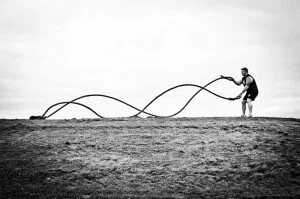David Handcock, Ireland Senior Rugby League Strength and Conditioning Coach and Owner of Hybrid Elite Performance, is here and will be doing articles for us every month with everything rugby. This week he’s talking about Gym Programming for Rugby Players.
Programming the Novice Power Athlete
Every Athlete wants improvement. They want to be a step ahead of their competition, no matter
what level. As a result of this ‘want’, they have to train harder than they are already. They want to be
stronger, fitter, faster, more powerful and more agile. They watch YouTube videos of elite athletes
training. They read fitness magazines. Reading and research is all well and good. Knowledge is
- But when applied incorrectly, it can lead to regression, setbacks and injury. It is at this critical
point where things can take a dramatic turn.
Do things right and you progress, you improve. Do things wrong and you regress and make things worse.
The reason for this is that most athletes do not know where to start. Training is the best part. It’s fun.
But before all projects, you must go through a checklist. This may not be fun but it is an absolute
necessity. You must build a solid foundation in order to have a solid building. The exact same applies
to performance development.
Some people are born athletes. They have gifted genetics. They move easily and adapt quickly.
The body moves in harmony. For those that are not born athletes, they have to work that bit harder.
Training development is all about efficiency. How efficient your joints move. How efficient your
muscles function, perform and recover from a training stimulus. If some of your joints and muscles
only have 75% mobility and flexibility (R.O.M), then the most you will get out of those joints will be
75% efficiency. That is a 25% deficit, a huge loss of potential power and potential development.
Any mobility and flexibility issues must be identified, addressed and corrected before that area even
touches an external load.
If there is a weak link in your foundation, where do you think that foundation will fail once your
start laying blocks and increasing the load on to it? Once that point begins to fail and then starts
to collapse, all of your focus must go into fixing that part of the foundation. Treatment and Rehab
follows. Injuries are a major setback. Yes, they do happen. But we can reduce the severity of that
injury and prevent the injuries to occur if we identify and address the weaknesses first. A building is
only as strong as its foundation, and once you apply the same principle throughout the construction of
your entire building, you are preparing for success and preparation is key to success.
Weaknesses are identified through a FMS, Functional Movement Screening. Gray Cook came up
with the idea for the FMS. He wanted to find a way to identify movement and stability flaws in athletes
that was looking to develop strength, power, speed, agility and sports skills. It would uncover flaws
that would normally be missed if not screened properly. The movements that make up the FMS are
basic and are the foundation for all human movement. They require good flexibility and control. An
athlete who is unable to perform a movement correctly shows a limitation within one of the movement
patterns or demonstrates an obvious difference between the function of the left and right side of the
body. This results in the discovery of a significant piece of information that may be key to limiting and
preventing injury while improving overall sporting performance.
An athlete cannot and must not focus on improving their strengths while an obvious weakness is
present. Address the weakness first and then strengthen it. The FMS is made up of seven movements
in total:
• Squat
• Step
• Lunge
• Reach
• Leg Raise
• Push Up for trunk control
• Rotational Stability
If testing reveals poor mobility and stability, you must focus on an effective fundamental mobility and
stability program before any kind of training. The movements used for this program should then be
incorporated into your warm up and your actual training program. Don’t just correct the weaknesses,
strengthen them. If more than one movement problem is present then focus on one movement
problem at a time. Always address the imbalance with the greatest limitation or difference first.
Once your problem areas have been corrected, the design of training program can begin. When
training for a sport, it is important that your training program reflects the movements used in the
sport and the metabolic pathways that are targeted during the sporting event. That sounds obvious
to some, but so many athletes, novices, amateur and even semi-professional/professional use the
wrong exercises and exercise combinations and as a result waste valuable training time. We are not
bodybuilders, we are athletes and we don’t train muscles, we train movements.
You must break down the elements of your sport, its movements, and its functions. You must replicate
these movements and functions in the weight room and training paddock. If you want to be a powerful
and explosive athlete then you must train for power and explosiveness. You have to move heavy
weight fast. You cannot move a heavy weight slow. That is not specific to a power based sport. You
have to combine heavy movements with explosive movements.
This leads us to a training system known as Complex Training. Developed in Eastern Block countries
and utilised by Russia and East Germany from the 1970’s on, Complex training is essential for
strength and power sports. It should be the core of every strength/power based training program.
Donald Chu is an expert in the field and published many papers and books about it. I would highly
recommend researching his material.
Before we get into Complex Training, you must address your weaknesses, correct them and turn
them into your strengths. Then develop the appropriate program specific for your sport. That is
programming. By doing it correctly, you give yourself the very best chance of succeeding.
Complex Training
As i have said, Complex Training is a method of training that was developed in Eastern Europe to
blend results of heavy weight training with plyometrics. It consists of four components;
- Resistance Training
• Plyometric Training
• Sprint Training
• Sport Specific Training
When these components are worked separately, they will make a good athlete, but when they are
worked together, they will make a great athlete. Complex Training is a combination of heavy weight
training and plyometrics in the same workout session. Plyometrics are used in between sets or even
part of the working weight training set. For example, if a workout calls for 4 sets of Squats, the athlete
will perform box jumps between sets. This is known as a Complex Training set, and the athlete doing
it enjoys the best results and benefits most from their training.
Resistance Training
Resistance Training is not just weight training. Resistance training encompasses throwing medicine
balls, mobility using tubing and bands and performing body weight exercises. Resistance training is
classified as anything that makes a muscle work harder.
Strength training raises the body’s ability to excite the motor neurons by nearly 50%. As a result,
this gives the nervous system more involvement in the workout, which in turn, prepares the muscles
for even greater challenges. The activity must be at a high intensity of strength training to achieve
best results. The resistance training portion of the complex training will consist of low repetitions of
moderate to heavy loads. This style of training produces the greatest amount of motorneuron firing
and muscle fiber recruitment and therefore prepares the body for explosive plyometrics.
For example, you could perform 3 reps with a heavy load as possible in the Bench Press followed by
a Medicine Ball Chest Press throwing exercise or Plyometric Push Up for the same muscle.
Plyometric Training
Plyometrics consist of jumping, hopping, skipping and throwing activities designed to make you faster.
During the plyometrics component of Complex Training, you must train at maximum explosive speeds
for maximum results. If you want your muscles to perform at higher speeds, you must train them at
higher speeds. Whatever you put into your training, you will get out.
When performing quick explosive movements, you must allow for minimal contact for the ground
(lower body) or hand contact surface (upper body).
Lower body Plyometric exercises emphasize quick foot movements and the ability to get off the
ground quickly. Upper body Plyometric exercises emphasize using medicine balls to teach the
muscles to respond more quickly to external forces.
Sprint Training
Speed movement depends on two factors; Stride Length and Stride Frequency. Stride Frequency is
largely dependent on the genetic makeup of your muscle fiber tissue. It can be improved by pushing
harder and faster off the ground. It is more difficult to improve stride frequency due to your genetic
makeup. Therefore athletes look to improving Stride Length. An increase in stride length allows
athletes to cover the same distance as athletes with greater stride frequency in the same amount of
In order to increase the ability to push off the ground with more power, your workouts may have to be
shorter but at a much higher intensity with longer rest periods between sets. Quality not quantity is
essential here.
Care must be taken as these workouts are extremely stressful on the nervous system. Therefore
adequate rest must be taken in between sets. Recovery is paramount. Rest times should vary
between 90 and 180 seconds.
Sports Specific Training
When training specifically for your sport, you must try to re-create the exact or very similar movements
that are required and occur as part of your sport. The movements must be copied and applied to a
working set of resistance training.
Complex training allows the athlete to work muscles in such a way that their slow twitch endurance
fibers behave like fast twitch explosive power fibers. It is these fast twitch fibers that are a key to a
powerful athlete.
The idea is to stimulate the fibers you want with resistance training, then perform a sports specific
movement or movements.
For example, a basketball player or a rugby union lineout jumper needs to train their jump power in
order to improve their jump height. The player should perform a heavy set of double or triple Squats or
Squat variation and immediately follow this with a set of repeated box jumps or rim jumps. See below
for more exercise pairing examples.
Example Pairing Exercises
• Front Squat/Box Jumps
• Bench Press/Medicine Ball Chest Pass
• Lat Pulldown/Underhand Medicine Ball Throw
• Dumbell Shoulder Press/Overhead Throw
• Crunches/Sit-up Pass
• Incline Bench Press/Plyometric Push-Up
• Split Squat/Box Jumps/Depth Jumps
• Seated Cable Row/Standing Backward Medicine Ball Throw
• Squat/ Lateral Hurdle Hops
• Hang Cleans/Hurdle Hops
The list goes on.
We have only just scratched the surface here. But this is the direction you must go and the steps you
must take in order to maximise your potential. In my facility, and with these programming models and
modifications, I have turned average overweight, unconditioned athletes into lean, powerful, functional
movement efficient elite machines. Like everything worth while, the challenge is immense, it is difficult
but the rewards are great. Be great.

 Facebook
Twitter
Google+
Youtube
Instagram
Email
Facebook
Twitter
Google+
Youtube
Instagram
Email
